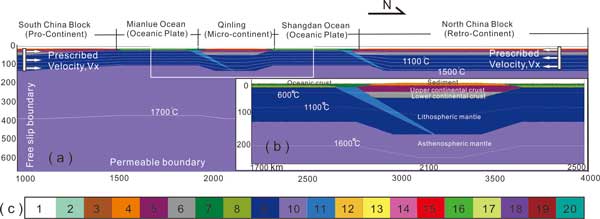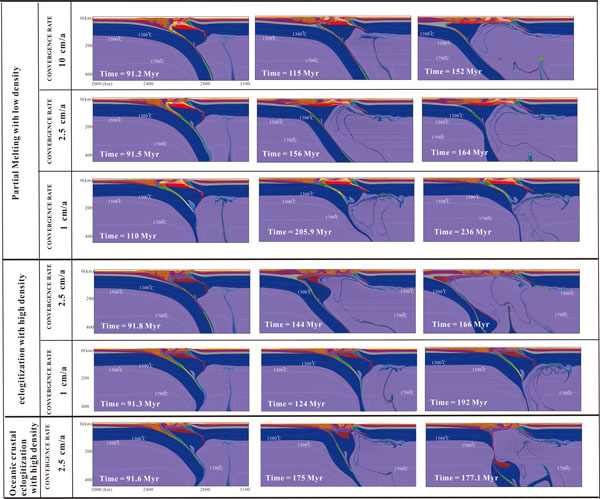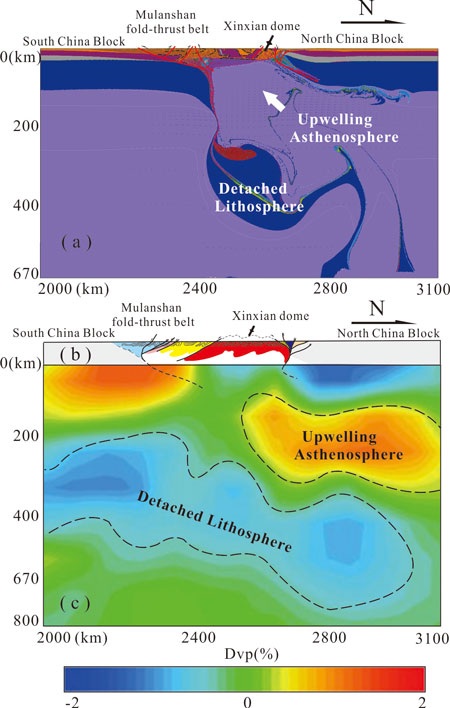 |
Post-orogenic unrooting and collapse in double suture systems: insights from the Western Dabie Orogen |
Liming Dai1,2, Sanzhong Li1,2 Zhong-Hai Li3 Ian Somerville4 Xiaochun Liu5
1Submarine Geosciences and Prospecting Techniques, MOE and College of Marine Geosciences, Ocean University of China, Qingdao 266100, P.R. China; dlming.geo@gmail.com ; Sanzhong@ouc.edu.cn
2Laboratory for Marine Geology, Qingdao National Laboratory for Marine Science and Technology, Qingdao 266237, P.R. China
3Key Laboratory of Computational Geodynamics, College of Earth Sciences, University of Chinese Academy of Sciences, Beijing, China, li.zhonghai@ucas.ac.cn
4UCD School of Earth Sciences, University College Dublin, Belfield, Dublin 4, Ireland, ian.somerville@ucd.ie
5Institute of Geomechanics, Chinese Academy of Geological Sciences, Beijing 100081, PR China, liuxchq@cags.ac.cn
This webpage is a summary of Dai L, Li S, Li Z-H, Somerville I, Liu X. Dynamic processes and mechanisms for collision to post-orogenic extension in the Western Dabie Orogen: Insights from numerical modeling. Geological Journal 2017; 1–15 https://doi.org/10.1002/gj.2993
Introduction
Post-orogenic extension is the last stage at the end of Wilson cycles in both ancient and modern continental collisional zones (Rey et al., 2001; Wang et al., 2014). Although it is generally appreciated that unrooting and collapse of orogens are related to slab break-off (von Blanckenburg & Davies, 1995), large-scale lithospheric delamination (Bird, 1978, 1979; Li et al., 2016), or the convective removal of continental lithosphere (Liu et al., 2004), all these models are based mostly on single subduction-collision systems and do not consider how multi-suture systems affect post-orogenic extension. In the Western Dabie Orogen, double (U)HP metamorphism zones (Li et al., 2017a,b), two episodes of migmatization (Zheng, 2008), typical extensional tectonics (Li et al., 2007, 2009, 2011, 2010) and thin lithosphere (Jiang et al., 2015; Xu et al., 2016) suggest that a double-suture system may have controlled the post-orogenic extension.
In this webpage we summarise the work of Dai et al. (2017), presenting thermo-mechanical models to compare with the most important characteristics of the deformed Western Dabie HP-UHP terrane. We further investigate the evolution and mechanism of post-orogenic extension in double-suture systems.
Numerical modelling
In keeping with the structure of the Western Dabie Orogen and similar regions (Gerya et al., 2002), our model includes a pro-continent (the North China Block), two oceanic domains (the Shangdan and Mianlue oceans), a micro-continent domain (the Qinling Micro-continent) and a retro-continent (the South China Block). Motion of the proto- and retro-plates is defined by prescribing constant convergence rates Vl and Vr respectively in small internal domains (Figure 1).

Figure 1. Initial model configuration. (a) Enlargement (3000 x 670 km) of the numerical model shows composition field and boundary conditions. The isotherms (white lines) are plotted for each 500°C increment. (b) The zoomed domain shows detailed model structure. The isotherms (white lines) are plotted for each 500°C increment. (c) The colored grid for different materials: 1- air; 2- water; 3-, 4- sedimentary cover; 5- upper continental crust; 6- lower continental crust; 7- upper oceanic crust; 8- lower oceanic crust; 9- lithospheric mantle; 10- asthenospheric mantle; 11- initial subduction zone (weak zone mantle); 12- and 13- partially molten sediment (3- and 4-); 14- and 15- partially molten continental crust (5- and 6-); 16- and 17- partially molten oceanic crust (7- and 8-); 18- upper continental crust eclogitization (12-, 13- and 14-); 19- lower continental crustal eclogitization; 20- oceanic crustal eclogitization (16- and 17-). The partially molten crustal rocks (12- and 17-) and crustal eclogitization (18-, 19- and 20-) are not shown but appear during the evolution of the model (Figures 2 and 3). Click here or on figure for enlargement.
Besides the convergence rates, the negative buoyancy resulting from eclogitization of the lower crust of the Qinling Microcontinent, which leads to Rayleigh-Taylor gravitational instabilities (England & Houseman, 1989), is one of the most important driving forces for lithosphere delamination or orogenic unrooting to produce post-orogenic extension. In our model, the micro-continent subducts to about 60-120 km, which leads to partial melting or eclogitization in the lower crust. The partial melting and retrograde metamorphism of the HP-UHP rocks in the lower crust can decrease the density of the lithosphere, but the eclogitization after partial melting can increase the density of the lithosphere.
We therefore tested two models, one with relatively low density and one with high density of the lower crust after exhumation of HP-UHP rocks, to explore how density change affects lithosphere delamination and post-orogenic extension (Figure 2). Combining these results with geophysical, geological and geochemical data (Jiang et al., 2015; Li et al., 2017a; Zheng, 2008), we suggest that the model with the oceanic crust and the micro-continental crustal eclogitization at medium convergence rates is more reasonable (Figure 3).

Figure 2. Temporal evolutionary sequence of post-orogenic extension with different convergence rates affected or not affected by crustal eclogitization. Click here or on figure for enlargement.

Figure 3. Comparison of the last model with geological data and tomography in the Western Dabie Orogen. (a) Vertical cross-sections of P-wave tomography across the Western Dabie Orogen (after Jiang et al., 2015). (b) A schematic geological traverse across the Western Dabie Orogen (after Li et al., 2010).
The mechanism of post-orogenic extension in the Western Dabie
We suggest that two factors can affect the evolution of post-orogenic extension in the Western Dabie, (i) re-subduction of the North China Block after slab break-off, and (ii) lower-crustal eclogitization during post-orogenic extension. Our results show that the pro-continental resubduction along the Mianlue Suture, corresponding to the last stage of compressional deformation in the Western Dabie Orogen (Li et al., 2010), could have resulted in subduction of the residual lithosphere and delay in the eduction (i.e. exhumation of subducted/accreted material at an ocean-continent margin) of the residual lithosphere and upwelling of asthenosphere to the end of subduction. After that, the collapse of the orogen would have begun gradually. The degree of collapse would mainly depend on the subduction depth of the residual lithosphere and eclogitization of the crust.
With decrease in subduction depth and increase in density by eclogitization, the degree of collapse caused by upwelling of the athenosphere reduces and the time interval from slab break-off to voluminous magmatic activity lengthens. For example, in the low-convergence-rate models with or without crustal eclogitization, slow and stable upwelling of asthenospheric mantle took longer (about 110 Myr) to delaminate a small range of lithospheric mantle under the collision zone. This is clearly longer than suggested by geochronological data (Xu et al., 2016). However, in the medium-convergence-rate model with crustal eclogitization, the root of the orogen was completely detached by Rayleigh-Taylor gravitational instabilities and replaced by upwelling asthenosphere. This suggests that the subduction depth of residual lithosphere is controlled by the convergence rate and crustal eclogitization controls the orogenic belt collapse process.
References
-
Bird, P. (1978). Initiation of intracontinental subduction in the Himalaya. Journal of Geophysical Research: Solid Earth 83, 4975-4987.
-
Bird, P. (1979). Continental delamination and the Colorado Plateau. Journal of Geophysical Research: Solid Earth 84, 7561-7571.
-
-
England, P. & Houseman, G. (1989). Extension during continental convergence, with application to the Tibetan Plateau. Journal of Geophysical Research: Solid Earth 94, 17561-17579.
-
Gerya, T.V., Stöckhert, B. & Perchuk, A.L. (2002). Exhumation of high-pressure metamorphic rocks in a subduction channel: A numerical simulation. Tectonics 21, 6-1 – 6-19.
-
Jiang, G., Zhang, G., Zhao, D., Lü, Q., Li, H. & Li, X. (2015). Mantle dynamics and Cretaceous magmatism in east-central China: Insight from teleseismic tomograms. Tectonophysics 664, 256-268.
-
Li, Z.-H., Liu, M. & Gerya, T. (2016). Lithosphere delamination in continental collisional orogens: A systematic numerical study. Journal of Geophysical Research: Solid Earth 121, 5186-5211.
-
Liu, M., Cui, X.. & Liu, F. (2004). Cenozoic rifting and volcanism in eastern China: a mantle dynamic link to the Indo–Asian collision? Tectonophysics 393, 29-42.
-
Li, S., Zhao, S., Liu, X., Cao, H., Yu, S., Li, X., Somerville, I., Yu, S. & Suo, Y. (2017). Closure of the Proto-Tethys Ocean and Early Paleozoic amalgamation of microcontinental blocks in East Asia. Earth-Science Reviews http://doi.org/10.1016/j.earscirev.2017.01.011.
-
Li, S., Kusky, T.M., Wang, L., Zhang, G., Lai, S., Liu, X., Dong, S. & Zhao, G. (2007). Collision leading to multiple-stage large-scale extrusion in the Qinling orogen: Insights from the Mianlue suture. Gondwana Research 12, 121-143.
-
Li, S., Kusky, T.M., Liu, X., Zhang, G., Zhao, G., Wang, L. & Wang, Y. (2009). Two-stage collision-related extrusion of the western Dabie HP–UHP metamorphic terranes, central China: Evidence from quartz c-axis fabrics and structures. Gondwana Research 16, 294-309.
-
Li, S., Kusky, T.M., Zhao, G., Liu, X., Zhang, G., Kopp, H. & Wang, L. (2010a). Two-stage Triassic exhumation of HP–UHP terranes in the western Dabie orogen of China: Constraints from structural geology. Tectonophysics 490, 267-293.
-
Li, S., Kusky, T.M., Zhao, G., Liu, X., Wang, L., Kopp, H., Hoernle, K., Zhang, G. & Dai, L. (2011a). Thermochronological constraints on two-stage extrusion of HP/UHP terranes in the Dabie–Sulu orogen, east-central China. Tectonophysics 504, 25-42.
-
Li, S., Jahn, B.-m., Zhao, S., Dai, L., Li, X., Suo, Y., Guo, L., Wang, Y., Liu, X., Lan, H., Zhou, Z., Zheng, Q. & Wang, P. (2017). Triassic southeastward subduction of North China Block to South China Block: Insights from new geological, geophysical and geochemical data. Earth-Science Reviews 166, 270-285.
-
Rey, P., Vanderhaeghe, O.,& Teyssier, C. (2001). Gravitational collapse of the continental crust: definition, regimes and modes. Tectonophysics, 342, 435-449.
-
von Blanckenburg, F., & Davies, J.H. (1995). Slab breakoff: A model for syncollisional magmatism and tectonics in the Alps. Tectonics 14, 120-131.
-
Wang, M., Song, S., Niu, Y. & Su, L. (2014). Post-collisional magmatism: Consequences of UHPM terrane exhumation and orogen collapse, N. Qaidam UHPM belt, NW China. Lithos 210–211, 181-198.
-
Xu, Y., Zhang, S., Griffin, W.L., Yang, Y., Yang, B., Luo, Y., Zhu, L., Afonso, J.C.,& Lei, B. (2016). How did the Dabie Orogen collapse? Insights from 3-D magnetotelluric imaging of profile data. Journal of Geophysical Research: Solid Earth 121, 5169-5185.
-
Zheng, Y. (2008). A perspective view on ultrahigh-pressure metamorphism and continental collision in the Dabie-Sulu orogenic belt. Chinese Science Bulletin 53, 3081-3104.
last updated 9th
February, 2018 |
